- 22
- Sep
High alumina special-shaped brick
High alumina special-shaped brick

Special-shaped refractory bricks can withstand various physical and chemical changes and mechanical effects at high temperatures. The special-shaped refractory brick is a refractory material with a certain shape and size.
Special-shaped refractory bricks can be divided into fired bricks, unfired bricks, fused bricks (fused cast bricks), and refractory and heat-insulating bricks according to the preparation process. In addition, special-shaped refractory bricks can be divided into standard bricks, ordinary bricks, and shape-turned bricks according to their shape and size. Special-shaped refractory bricks can be used as high-temperature building materials and structural materials for building kilns and various thermal equipment.
The price of special-shaped refractory bricks depends on the difficulty of the forming process and the material of the refractory bricks. Generally, refractory manufacturers will ask the purchaser to provide the original brick drawings when quoting special-shaped refractory bricks. You need to know every angle, every radian or The thickness, length, height, etc. of each figure. Therefore, when you need to inquire about the price of special-shaped bricks, please provide detailed design drawings or other related materials, so that we can quickly and accurately calculate the price of special-shaped refractory bricks for you.
1. Refractoriness: Refractoriness is the property of refractory bricks that can resist high temperatures without melting during use, and is one of the important indicators for evaluating quality. If the refractoriness is not high, a large amount of liquid phase will be generated inside the brick due to the long-term high temperature during use, which will cause all the masonry to be destroyed by melting. The degree of refractoriness depends on the chemical mineral composition of the raw material, the particle composition of the raw material, and the viscosity of the liquid phase.
2. Load softening temperature: The load softening temperature is related to the structural strength of the kiln at high temperatures. Generally, it is expressed by the temperature of a certain amount of deformation caused by refractory bricks under a static load of 2 kilograms per square centimeter. The glass phase is small, the crystallization forms a network structure and the brick with a low porosity, and the load softening temperature is higher.
3. Compressive strength at room temperature: indicates the structural strength of refractory bricks and the ability to bear static loads: it has a great relationship with the brick’s resistance to impact and friction. The compressive strength depends on factors such as the density of the product, the composition of the raw material and the degree of sintering.
4. Porosity: Porosity has a great relationship with slag erosion resistance. The slag erosion resistance mainly depends on the chemical properties of the refractory material (acidic, alkaline, neutral). Clay bricks are partly acidic refractory materials. Increasing the content of AL2O3 can increase the corrosion resistance to acid and alkaline slag. The material with the same chemical properties will increase the contact area between the brick and the molten slag due to the large porosity, so that the molten slag penetrates into the brick body through the pores, and the slag corrosion resistance is reduced. The porosity depends on factors such as the particle composition of the pellets, the bulk density and the degree of sintering of the same product.
5. Remaining line shrinkage: the volume fixation of refractory material at high temperature when the remnant line shrinks. Due to the long-term heating of the bricks during use, the bricks are further sintered, and the volume shrinks, causing cracks and deformation of the furnace body. In order to reduce residual shrinkage, the product should be fired at a sufficient temperature.
Physical and chemical indicators:
| Rank/Index | High alumina brick | Secondary high alumina brick | Three-level high alumina brick | Super high alumina brick |
| LZ-75 | LZ-65 | LZ-55 | LZ-80 | |
| AL203 ≧ | 75 | 65 | 55 | 80 |
| Fe203% < | 2.5 | 2.5 | 2.6 | 2.0 |
| Bulk density g/cm2 | 2.5 | 2.4 | 2.2 | 2.7 |
| Compressive strength at room temperature MPa> | 70 | 60 | 50 | 80 |
| Load softening temperature °C | 1520 | 1480 | 1420 | 1530 |
| Refractoriness °C> | 1790 | 1770 | 1770 | 1790 |
| Apparent porosity% < | 24 | 24 | 26 | 22 |
| Heating permanent line change rate% | -0.3 | -0.4 | -0.4 | -0.2 |
